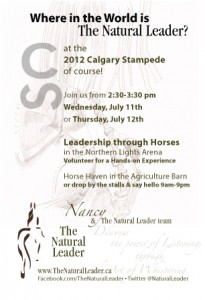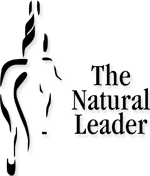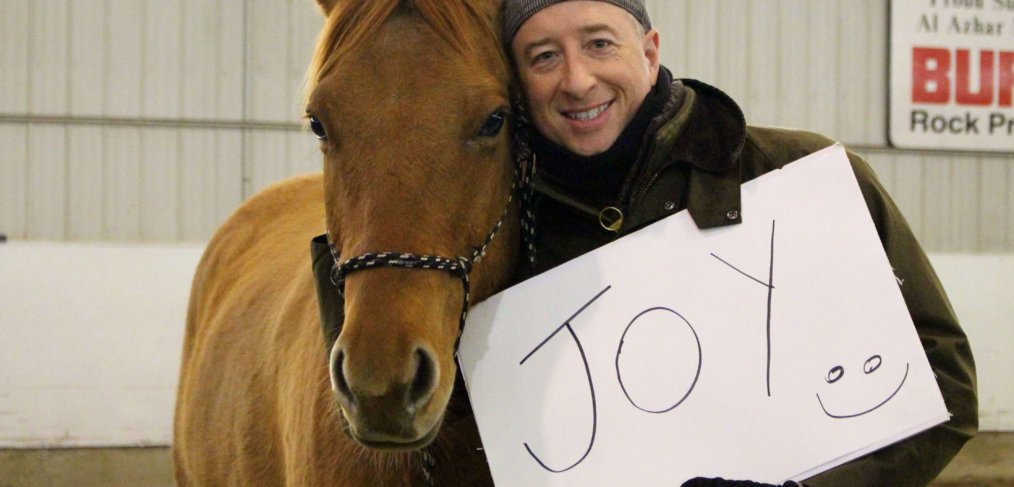This interview is a slight deviation from my conversations with leaders about what they have learned from a life with horses. Simply because every once in a while something worth sharing happens in The Natural Leader programs. Aside from the odd trail ride, Steve’s experience with horses is not a whole lot broader than the day he spent with us. What showed up for for Steve that day speaks to the power of leadership learning through horsemanship.
“What I always found dealing with a horse or a human everybody has a history. You want to be cognitive of that history but you don’t want to pack it more than they do.” Murray McGonigle
“Is being Lucky to do what you love the end game? Or is it the process”
Silver Award – Blended Learning The Institute for Performance & Learning
 Schwung Isn’t that an awesome word?
Schwung Isn’t that an awesome word?
A few of the definitions you will find are momentum; swing; flourish or impulsion. A German word more often heard in dressage circles, Schwung is much more than any one of those words. The fourth level of the dressage training scale, Schwung refers to “the circuit of energy from the rider through the hind end to the front end of the horse.” or the fluid and seemingly effortless motion of horse and rider moving as one. Successful development of the foundational elements of knowledge, practice and awareness determine if you ever achieve Schwung.
It is this very combination that relates so perfectly to the concept of presence and the art of leadership.As with leadership, the dressage scale is both linear and cyclical. When one point, activity or task is achieved with one individual we have the opportunity to go through it in a similar but different fashion with another. Dressage is the constant pursuit of self improvement.
Relaxation the foundation and first stage of the training scale. This stage is about forward movement and gaining comfort in the company of each other, developing confidence and creating the willingness to learn. Like the foundation of leadership it is about a relationship based on a common language and trust.
Rhythm is about being able to maintain forward motion with clarity and understanding as the tasks become more complex. Here we begin to ask more of the horse and in turn a balance in the roles and responsibilities in the relationship. As we begin to delegate more we can see where another’s behaviour might be a reflection of our request. You are developing your Awareness of Others and your ability to be flexible as you assist someone else to be their best.
Contact is about confident forward motion with a soft, steady connection between horse and rider. Relaxation and Rhythm in place the horse and rider find a common balance point. Here we begin to truly delegate responsibility, encouraging the horse to offer their best.
Ironically Contact is where most relationships begin. Be it horse or human, this is where we know what it is supposed to look like and in the effort to get results we resort to control. In horsemanship it looks like bigger bits, spurs and hard hands, in leadership it is about titles and how much we know and just doing it ourself.
Letting go of the impulse to “take control” is a tough one as it requires us to be confident in the face of the unexpected. It should be about channeling the forward energy and the potential of what it could be. The greatest challenge comes in trusting ourself first and being willing to take the time it takes. Reaching Schwung requires a high degree of self awareness and confidence.
While achieving Schwung may be a goal, it is not the final stage of the Dressage Training Scale. The beauty in choosing an art form is there are so many ways to interpret and apply what you learn. There are no end points in fine horsemanship or leadership, there is always a new opportunity to achieve the seemingly effortless way of being.Achieving Schwung is my current journey in the arena and through the written word. I find Schwung, then I feel like I lose it, It is taking longer than I thought it should it, then again I never realized how much I had to learn. Thank you for joining me on this path.
 It should have been easy. The idea was simple enough, get Gabe used to stuff happening around him.
It should have been easy. The idea was simple enough, get Gabe used to stuff happening around him.
I have learned how complicated simple can be. Now well past ninety days, we continue one step at a time working through the Tarp Challenge. Gabe remains hesitant about the blue tarp, but what has changed it is that it is no longer about getting him used to the tarp. It is now about how I offer the information and allow him the opportunity to interpret my intention. To a horse everything means something and nothing, means nothing. We are getting closer to nothing.
Horsemanship is a journey and each day with Gabe, each session with people I learn more about how I present myself. Through recent programs leadership presence has been the focus of conversation. We begin each session asking what would each individual like to get out of their day, defining a goal for themselves. We hear a lot about what they would like to see in their staff, changes in how their communication is received or thoughts that relate to getting others to perform their best, for some it is a challenge to get them to see the role they play in that outcome.
It takes seconds for a horse to figure out a person’s “I statement”. However, having the human articulate it plainly and clearly is another story. When they find it, it is gold for us in the arena.
To be honest it really doesn’t matter whom I pair with who or what activities we have planned for a sessions. The horses simply do what they do and the people will say the the most amazing things. I so love to hear it when someone simply states what they need to do differently as a result of the interactions with the horse. What was challenging for them to articulate in the classroom rolls off their tongue in the arena.
I am so proud of my horses. They do not just tolerate another human on the end of the lead line, but they share with them something that becomes so profound. I know that person is leaving with a whole new perspective on what leadership presence means to them.
Just as it is no longer about getting Gabe used to the commotion going on around him, but rather about how “I can support and help Gabe understand that he can trust me through whatever may be happening around us.” I still want Gabe to accept a blue tarp, but it is what I am willing to do in order for him to get there that makes the difference.
What’s in it for me? Immense satisfaction on what I can accomplish if I set my heart and mind to something.
 A very unsettled horse was leaping toward me and the chances of one or all four feet hitting me was very high. So yes I moved my feet!
A very unsettled horse was leaping toward me and the chances of one or all four feet hitting me was very high. So yes I moved my feet!
In a horse’s world, who moves who’s feet is a clear case of leader. So while Gabe was trying to unload the saddle, or what he perceived as a threat, moving my feet was NOT what I was supposed to do. Getting the horse to move his feet forward is the goal, to achieve that you need to move yours. This simple, but not necessarily easy tactic, will help him find the comfort and leadership he needs.
At that particular moment, it was hard to determine if being on foot was actually a good thing. Not a bronc rider by skill I have been seeking out help from a few experts to get me work through the glitches so Gabe joined me in Montana to ride with Buck Brannaman. If you have read previous articles or seen the movie BUCK then his philosophy will sound familiar “Horsemanship isn’t about working on the horse, it’s about working on you.” A thought that influences my horsemanship and leadership in The Natural Leader programs.
A recent session once again highlighted the similarities between how horses and people can respond in a stressful situation.
She had executed not one but three downward dog stretches, two with a human on her back. While I noticed Sydney’s outward signs of stress I hadn’t taken into account it began when one woman took her lead. Sydney is a big horse and clearly demonstrates confidence in the herd, though like all horses is very sensitive to people’s stress. I should know by now that when Sydney starts these behaviours no matter how comfortable someone says they are, Syd knows better.
Through the first few strides of the team activity Sydney reached out three times to express her concern. On her third polite attempt contribute to the collective experience I suggested we synch the energy of the group with a deep breath, knowing full well that Sydney’s next attempt to communicate with this woman would not be lips only.
What happened next I expect reflects a typical response to a stressful situation. Rather than a deep yoga like breath I was on the receiving end of a verbal attack, apparently I was the source of all the stress. As if I had been bucked off, I stepped back.
While the participants bite was with words I was not about to let Sydney follow through on her promise. I had to shake off the momentary state of shock and step forward and shut the activity down to debrief what was going on.
When we say a horse is our mirror, through the activity Sydney had been reflecting the stress of the entire group, she was clearly demonstrating her vulnerability and that it was more than she could handle. I wish I could say the debrief was excellent, I have since thought of all the things I should have or could have said.
As Patrick Lencioni outlines in The Five Dysfunctions of a Team identifying vulnerability is the heart of creating trust. The work with horses often brings forward the emotions that expose vulnerability, people may miss or misinterpret it, the horses read it loud and clear. The most challenging part of team work is facilitating what shows up and engaging the team in a dialogue that can continue beyond the activities in the arena.
There is no shame in getting bucked off or failing to show up if we learn from what happened. As a leader I should have stepped in sooner to support Sydney. In my role as a facilitator I should have been able to use the situation to get the group talking about stress in the workplace. I recognize I was unprepared for what happened and I didn’t have the skill or experience to handle what showed up. I do now!
I want to be a better horseman, leader and human being. As long as I consider myself to be a work in progress that vulnerability allows room for improvement. The more I remember to step forward in a stressful situation the easier it will be to be confident and assertive even as I am learning. I may not always do exactly the right thing but at least I will be doing something.
 Celebrate the 100th Anniversary of The Calgary Stampede and join The Natural Leader in the Northern Lights Arena!
Celebrate the 100th Anniversary of The Calgary Stampede and join The Natural Leader in the Northern Lights Arena!
.
.REVISED TIME 2:00 PM BOTH DAYS

